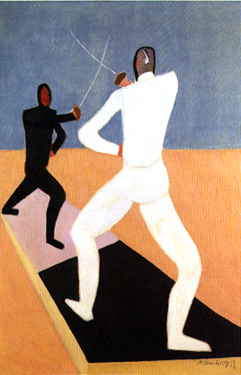
Milton Avery
American, 1893-1965 (active America)
Fencers, 1944
oil on canvas
32 x 48 in. unframed
SBMA,Gift from Mrs. Burton C. Tremaine, who also gave a gift in honor of her first husband, Max von Romberg, naming the von Romberg Gallery
1949.4

Self-portrait, Ink on paper, 1938, National Portrait Gallery, Smithsonian Institution
Hilton Kramer of the "New York Times" said, "Avery disregarded cubism, avoided the unhappy fate of many of his colleagues of drifting from one style to another. He achieved recognition chiefly from his fellow artists, not public."
RESEARCH PAPER
Milton Avery was born in Altmar, New York, in 1893. He lived most of his life in Connecticut and was instrumental in the formation of the Connecticut League of Art Students based in Hartford. Subjects for his artwork were from nature, sketches from his summer trips to Mexico, his wife, Sally, or his daughter, March. His works were influenced by Japanese prints and by the works of Gauguin and Matisse.
Avery, therefore, grew up out of the New York Art Scene of the Ashcan School, in his native Connecticut. His approach was foreign to most of the American artists of the 30's and 40's because he did not paint with the American scene. He was always loyal to his own sensibilities and never tempted by the isms (cubism) or the fads (abstract expressionism) of his time. He was avant garde in his youth relative to the Ashcan School (painting the world of the immigrants, shoppers, burlesque, etc.)
The most common comparison of his works is with those of Matisse. Both artists had the same art of balance, treated figures and landscapes primarily as patterns of harmonious arrangements. Both artists eliminated and simplified more and more. Both artists visualized their compositions from the start and considered first of all the overall expression. The composition was the art of arranging in a decorative manner the elements chosen to express their feeling. They both used color as expressive and intuitive.
One principle difference was in their use of color. Matisse used brighter, more intense hues while Avery used calm, muted hues with fewer brilliant accents. Hans Hoffman once said, "Avery was one of the first to understand color as a creative means. He knew how to relate colors in a plastic way."
Avery manipulated his colors in opposition to others, simplified his drawings, and distorted his figures into a couple of color shapes without making them grotesque. Avery's comment on his art was, "I like to seize the one sharp instant in Nature, to imprison it by means of ordered shapes and space relationships. To this end I eliminate and simplify, leaving apparently nothing but color and pattern. I am not seeking pure abstraction; rather the purity and essence of the idea, expressed in its simplest form. I work in two levels. I try to construct a picture in which shapes, spaces, and colors form a set of unique relationships, independent of any subject matter. At the same time I try to capture and translate the excitement and emotion aroused in me by the impact with the original idea."
Avery uses all these stylistic techniques in his oil painting, FENCERS. The subject matter is two large size fencers facing each other with swords touching. The painting was done with large, flat, dry brush strokes. The artist uses flat hues of black, turquoise, flesh, and emphasis on the whites interplaying between these colors.
Triangle shapes are apparent everywhere: the fencers' stances, their upraised arms, their crossing swords, the mats they stand upon. All these shapes give downward directions (heavy weightiness) to the figures. Using these shapes and these light and dark hues, the artist also creates a movement out towards the viewer with the black background and the foreground alternating in and out. There is a domino effect with the patterning of the ground.
The only use of lines is the crossing of the swords and the swift horizon line behind the figures. Very little texture is used except in the thick dabbling of the paint on the hair of the fencers. After looking at the painting for a period of time, the viewer becomes immersed in the shapes and the colors interplay with one another with disregard for the subject matter. These help create staccato rhythm comparable to the sparring between the fencers.
Milton Avery was a gifted artist and not only worked in oil but also used the following media: gouache, oil crayons, pencil and etching. He was a talented American artist of the 20th century with many one-man shows during his lifetime.
Prepared by Christina Putz Nuckols, March 1978
SBMA CURATORIAL LABELS
Though the subject matter of fencing recurs in Avery’s work, this is the most collage-like and daringly flat version of the motif that he produced. The 1940s saw Avery veering increasingly in the direction of pure abstraction, foregoing all but the most essential means by which to identify his subjects. In this painting the dynamic movements of the fencers’ post and riposte are expressed through plunging orthogonal lines, created by what could be mistaken for collaged pieces of cut paper, affixed to the surface of the canvas. Paint is thinly applied in contrasting colors and the brushwork is barely discernible in this minimalist version of concentrated repartée.
- Highlights of American Art, 2020
